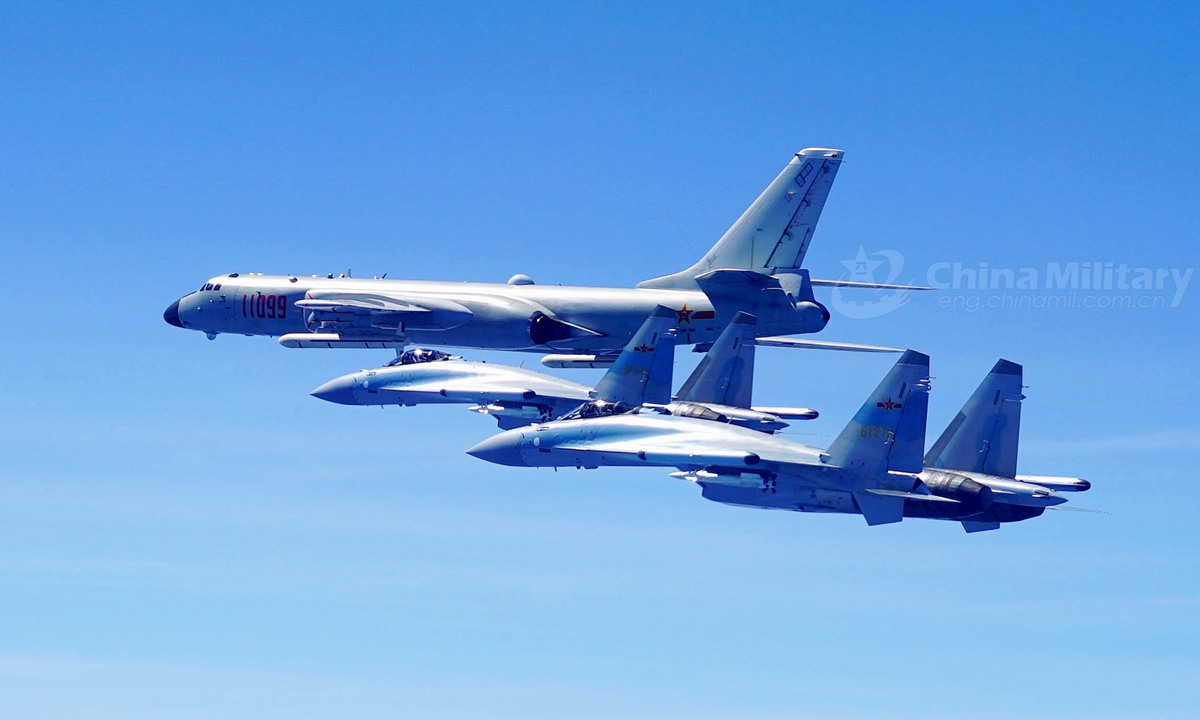
Two Su-35 fighter jets and a H-6K bomber fly in formation on May 11, 2018. The People's Liberation Army (PLA) air force conducted patrol training over China's island of Taiwan on Friday. Su-35 fighter jets flew over the Bashi Channel in formation with the H-6Ks for the first time, which marks a new breakthrough in island patrol patterns, said Shen Jinke, spokesperson for the PLA air force.Photo:China Military
The Chinese mainland conducted a series of aircraft exercises in the southwest airspace of the island of Taiwan on Saturday and Sunday, sending 13 and 15 fighter jets respectively in the two days, many of which were main combat aircrafts of the People's Liberation Army (PLA). The Taiwan authorities are feeling the pressure, and the US State Department had issued a statement, urging the Chinese mainland to "cease pressure against" the island while reaffirming its commitment to the island. However, the juxtaposition of the three China-US joint communiqués, the Taiwan Relations Act and the six assurances mentioned in the US statement this time differs from the Trump administration's refusal to mention the three joint communiqués in his later period.
Why did the PLA send fighter jets to the island for large-scale near-Taiwan exercises at the beginning of the Biden administration? Interpretations by analysts in neither the US nor the island are reliable. In fact, it is normal for PLA fighters to fly around the island and across the so-called middle line of the Taiwan Straits. The US' Taiwan policy is also continuing with inertia, with no sign of adjustment being made at present. The whole situation is in the atmosphere and rhythm that had been formed previously.
The Biden administration is expected to bring some fresh air, but there is little evidence to support that expectation across the Taiwan Straits. The frame of reference by which analysts can use to interpret the specific actions is full of confusion and uncertainty, so it is difficult to guarantee that the interpretations will not deviate from the actual situation.
As a matter of fact, the basic framework for mutual understanding between China and the US has already been damaged. There are more and more areas where the two sides cannot understand each other, and the probability of each other's strategic miscalculation is increasing. For example, China may wonder what the recent activities by the USS Theodore Roosevelt aircraft carrier in the South China Sea meant, while the US may think about why the PLA fighters were conducting exercises near the island of Taiwan at this particular juncture? China will then wonder what the US means by issuing such a statement so soon. When the PLA's fighter jets flew into the southwest airspace of the island on Sunday, what would the US think of it and how would it react?
It is unlikely that the Taiwan authorities would change its stubborn policy of relying heavily on the US to resist the Chinese mainland; and it is undoubtedly that the mainland has the fastest-increasing force to dominate the situation across the Taiwan Straits. If Taiwan regional leader Tsai Ing-wen and her likes keep place their bets on the US' increasing support, and if the Biden administration follows former US secretary of state Mike Pompeo's extreme operations, the situation across the Taiwan Straits is doomed to deteriorate. It is at the least that the PLA fighters will fly to the southwest airspace of the island. Sooner or later, these fighters will appear over the island of Taiwan.
If the tension across the Taiwan Straits is to be eased, we must return to its deteriorating starting point, which is the Democratic Progressive Party (DPP) authorities in Taiwan refusing to recognize the 1992 Consensus and opposing the one-China principle. All tensions across the Taiwan Straits originate from the DPP authorities' perverse act. And this is in contradiction with the US establishment's general direction in controlling the situation in the Taiwan Straits, and is also incompatible with the three China-US joint communiqués. If the US places its China policy on the basis of the DPP authorities' reckless moves, which obviously have a trend of Taiwan secessionism, then it will bear long-term and cumulative strategic risks.
The easing of the tension in the Taiwan Straits should start from the political point of view. It cannot reach a breakthrough through strategy. The interaction among the Chinese mainland, the US and the island of Taiwan has been broken in all directions and is difficult to repair. In the later period of the Trump administration, the situation across the Taiwan Straits actually reached the edge of collapse. If the Biden administration does not want the situation to get out of control or get itself seriously involved, they should sent out a clear political signal to distinguish themselves from the previous administration's mischief, and restore the controllability of the Taiwan Straits on the basis of the one-China principle.
The danger is that Tsai has been in power for five years. Many American people have already forgotten the changes in the Taiwan Straits caused by Tsai and the DPP authorities. All the radical US public opinion remembers is the subsequent conflicts on the Taiwan question. The US has won Tsai, an active pawn to control China. And to a greater extent, Washington is already kidnapped by Tsai. The Biden administration has a very professional diplomatic team. Hopefully they can clarify the boundaries and importance of the US interests on the Taiwan question, and restore Washington's strategic sobriety.




